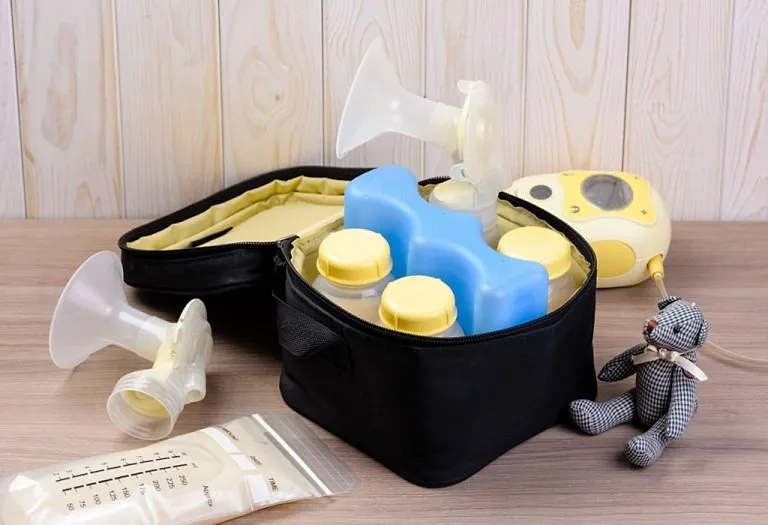Blocked Breast Milk Duct: Causes, Remedies, & Prevention

Among the many challenges that you will face after giving birth to your baby, starting to breastfeed your tiny tot for the very first time will be one. While it is known to be one of the most satisfying experiences of being a mother and bonds the mother and the child, you can be confronted with some unique challenges now. A common one encountered by many new mothers is that of blocked or plugged milk ducts, which can cause discomfort and frustration during breastfeeding. Addressing these issues promptly can help ensure a smooth feeding journey for both you and your baby. Read on to learn more about blocked breast milk ducts.
What Is a Blocked or Clogged Milk Duct During Breastfeeding?
While breastfeeding your baby, there will be times when you will feel your breasts getting fuller and engorged. This primarily happens when you are producing more milk in comparison to what is being expressed or consumed by your baby. This condition will lead to what is commonly known as a plugged milk duct, where the entire area around the milk duct is swollen and inflamed. If you inspect your breast, you will feel a hard lump which will cause slight shooting pain or itchiness around the entire area. It is essential to treat this clogged duct situation at the earliest as it could lead to fever. Milk blockage in the breast should be looked into immediately as it could lead to something more severe than just fever.
Causes of Clogged Milk Ducts
The primary reason for the occurrence of blocked milk ducts is because the milk being produced is not being effectively removed either by baby or by expression as frequently as it should be, thus leading to blockage. Milk may not be getting emptied from the breasts due to one of the following reasons:
- Your baby is having problems feeding because he is unable to latch on properly or isn’t feeding as much as he should.
- You may be using a nursing bra that is too tight, causing damage or compression of the milk duct and the trapping of milk inside the duct.
- Using a breast pump that does not exert enough pressure on the breast or exerts too much pressure and suction.
- Pumping with the wrong flange size.
- The weaning process has been too sudden.
- Having a cold or being stressed can cause blocked ducts too. The production of oxytocin (the hormone due to which breasts release milk) can be affected if the mother is under stress.
- Surgeries like breast biopsy could have an impact on the draining of milk, thus leading to a blocked duct.
- Having an excess of galactagogues and not feeding the baby on demand or letting the baby decide the nursing duration and frequency.
Symptoms of Clogged Milk Ducts
Wondering what are the signs of a blocked milk duct? If you have a blocked milk duct, you will notice that your breasts have a hard lump inside or feel ‘tight’. The area around the blockage may feel raw, tender and even have a reddish patch. The patch will also feel hot to touch or swollen, particularly after feeding. In some instances, an obstructed milk duct may be painful or tender without the feeling of a lump or puffiness. Local symptoms could also include a painful feeling before the feed and reduced tenderness post the feed, while the clogged areas will feel empty or smaller after you have fed the baby. Mothers could also develop a low fever if they suffer from a blocked milk duct. If fever persists it means the engorgement has escalated to infection and needs medical intervention from the gynaecologist.
Risks of Clogged Milk Ducts
Clogged milk ducts are a common issue that many breastfeeding mothers face. Understanding the risks associated with clogged milk ducts is important to ensure both the mother’s and baby’s health are maintained.
- Infection (Mastitis): If the duct remains clogged for an extended period, it can lead to a bacterial infection known as mastitis, causing pain, swelling, and flu-like symptoms.
- Decreased Milk Supply: Persistent clogged ducts can affect milk flow, leading to a reduced milk supply, which may impact the baby’s nutrition.
- Abscess Formation: In severe cases, untreated mastitis can result in the formation of an abscess, requiring medical intervention or even surgical drainage.
- Breast Engorgement: A blocked mammary duct can contribute to engorged breasts, making it harder for the baby to latch properly, causing discomfort and potential feeding issues.
What Are the Effects on the Baby?
While a clogged milk duct does not affect your baby, it does make nursing difficult for him. Since feeding involves extra effort, the baby may be reluctant to suck milk from the affected breast as the milk flow will tend to be slower than it usually is. It is also recommended to continue to nurse the baby while the milk ducts are blocked since breast milk has antibacterial properties and keeps the baby safe even if you have an infection due to the breastfeeding plugged ducts. Also, nursing regularly ensures that the blockage is removed.
Treatments for Curing Plugged Ducts While Breastfeeding
As an anxious mother, you would be wondering how to unclog a milk duct and relieve yourself of this condition, the accompanying pain and the discomfort. What is the process of a clogged milk duct treatment? The most proven way of curing blocked milk ducts is to keep on nursing and emptying the breast of milk. This will reduce inflammation, and you will feel more comfortable nursing the baby.
Here are a few tried and tested methods of treating plugged ducts that you can try:
- Begin with the affected breast: It will be painful but make sure you begin nursing from the affected side first as your baby will suck strongly when it is hungry. This may help to unclog the duct. In case your baby is unwilling to nurse on that side, use a breast pump or express milk by hand, as it is necessary to empty the breast.
- Massage the breast: Massaging the sore area frequently in a firm manner is also an efficient way of treating plugged ducts. It is vital to begin massaging from the outside and slowly work your way towards the affected nipple. You can also relieve the swelling and the pain by applying warm compresses just before you nurse, as this will help in opening the ducts to some extent.
- Change the nursing position: To ensure that all the ducts are completely drained, change the way you hold your baby. If the cradle hold is your preferred position, you could change over to the football hold. You could also try to nurse your baby lying down sideways. Place your baby close to your breast in a way that its chin points towards the sore area, help him latch on to the nipple and begin nursing. This will help the point of suction to be directed at the clogged duct.
- Get enough rest: It is critical for you to get as much rest as possible while you are breastfeeding your baby. If you do not have help at hand or have other children to take care of, getting rest may seem like an impossible task. Ask for help from relatives or friends and grab some shut-eye while they are around, tending to the baby. If you are alone, keep all the necessary stuff like diapers, toys, water, feeding cups, etc. nearby so you can avoid movement as much as possible.
- Medication: If this does not work, try medication after consulting with your doctor, since you are breastfeeding and any medication can affect the baby. Your doctor could prescribe certain pain-relieving medicines to help reduce the inflammation. Cold and hot packs will also help, and you can try both to see which one works for you.
Is It Possible to Squeeze Clogged Milk Ducts?
It is not recommended to aggressively squeeze clogged milk ducts, as doing so can cause further discomfort or injury. Instead, gentle techniques such as massaging the affected area toward the nipple or applying a warm compress can help soften the blockage and promote milk flow. Frequent breastfeeding or pumping, along with experimenting with different feeding positions, can also aid in clearing the clogged duct and preventing further complications. Always approach the situation with care to avoid worsening the issue.
Tips to Get Relief From Blocked Ducts Naturally
Apart from the clogged duct remedies mentioned above, there are also some home remedies to treat a clogged milk duct.
- Taking a hot shower and massaging the breast during the shower ranks higher than most remedies as a practical solution for blocked milk ducts.
- You can also apply coconut oil to the infected area as this will help to soften the area and reduce the pain to a large extent.
Prevention of Clogged Milk Ducts
Here are a few simple tips to help prevent blocked ducts
- Choose a well-fitting bra: Getting measured ensures that you pick one which does not apply pressure on any part of your breast, as this may block the flow of milk, leading to blocked ducts.
- Empty breasts regularly: Being too full can cause blocked ducts. If the baby is not nursing, make sure you express milk regularly.
- Change feeding positions: Encourage your child to nurse on the side where a blocked duct may be developing. This helps in unclogging the duct.
- Take anti-inflammatory medicines: Easily available, these medicines reduce inflammation, providing relief.
- Hot compress: A warm compress applied between feeds is a useful preventive measure.
- Destress: Lack of rest and stress can aggravate blocked milk ducts. Make sure you try your best to reduce stress by indulging in activities that may keep you relaxed.
When to Seek a Doctor’s Help
If the discomfort caused by blocked milk ducts increases over 24 hours, it is advisable to see a doctor who may prescribe antibiotics for relief.
FAQs
1. How long does it take for a clogged milk duct to resolve?
Most clogged milk ducts will resolve within 24 to 48 hours with proper care, such as frequent breastfeeding, massage, and warm compresses. However, if the duct remains clogged for longer or worsens, medical attention may be necessary to prevent infection or other complications.
2. Are clogged milk ducts more common in one breast?
Yes, clogged milk ducts are typically more common in one breast. It is often related to factors like uneven milk supply, poor latch, or incorrect feeding positions, leading to one side becoming more prone to blockages.
3. Can certain medications lead to clogged milk ducts?
Certain medications, like those that affect milk production or cause dehydration, may increase the risk of clogged milk ducts. Medications such as antihistamines or decongestants can reduce milk supply and contribute to blockages. It’s essential to consult with a healthcare provider if you’re on medication and notice changes in breastfeeding.
Although blocked milk ducts are a common phenomenon among breastfeeding mothers, one should take quick remedial action as mentioned above. However, if you do not find any significant changes in your condition, it is necessary to see the doctor and ensure that your condition is not leading to anything serious like mastitis as this will need a different line of remedies.
References/Resources:
1. Clogged Milk Duct; Cleveland Clinic; https://my.clevelandclinic.org/health/diseases/24239-clogged-milk-duct
2. Managing plugged ducts, mastitis when breastfeeding; Mayo Clinic Health System; https://www.mayoclinichealthsystem.org/hometown-health/speaking-of-health/managing-plugged-ducts-mastitis-when-breastfeeding
3. Everything You Need to Know about Clogged Milk Ducts; Penn Medicine Lancaster General Health; https://www.lancastergeneralhealth.org/health-hub-home/motherhood/fourth-trimester/everything-you-need-to-know-about-clogged-milk-ducts
4. Clogged Milk Ducts; American Academy of Pediatrics; https://www.healthychildren.org/English/ages-stages/baby/breastfeeding/Pages/Clogged-Milk-Ducts.aspx
5. Mastitis; Cleveland Clinic; https://my.clevelandclinic.org/health/diseases/15613-mastitis
6. Plugged Milk Ducts; Children’s Hospital of Philadelphia; https://www.chop.edu/centers-programs/breastfeeding-and-lactation-program/plugged-milk-ducts
7. Plugged Milk Ducts; Johns Hopkins Medicine; https://www.hopkinsmedicine.org/health/conditions-and-diseases/plugged-milk-ducts
Also Read:
Breast Milk Production Process
Breast Pain during Breastfeeding
Itchy Breast while Breastfeeding
Changes in Breast after Breastfeeding
Breast Compression during Breastfeeding
Tingling in Breast While Breastfeeding
Lump in Breast during Breastfeeding
Was This Article Helpful?
Parenting is a huge responsibility, for you as a caregiver, but also for us as a parenting content platform. We understand that and take our responsibility of creating credible content seriously. FirstCry Parenting articles are written and published only after extensive research using factually sound references to deliver quality content that is accurate, validated by experts, and completely reliable. To understand how we go about creating content that is credible, read our editorial policy here.


























